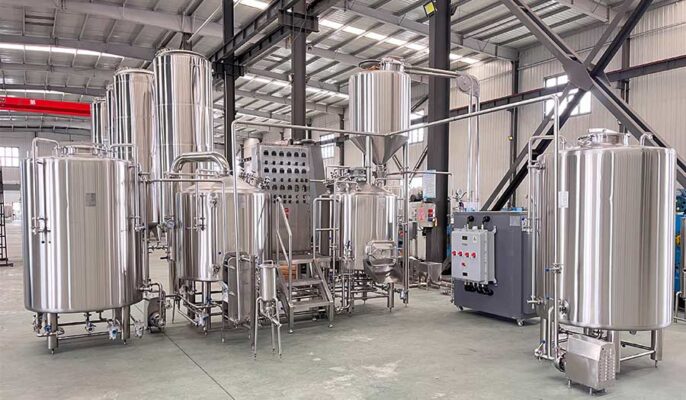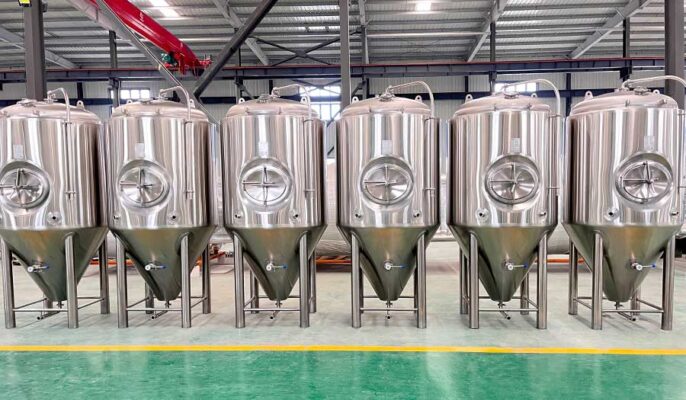Equipamento para fabrico de cerveja em pequenos lotes domina a indústria cervejeira. Ao contrário do fabrico comercial de cerveja, a cerveja em pequenos lotes oferece uma abordagem prática à produção. Cada etapa do processo pode ser personalizada de acordo com os gostos individuais. Neste guia, vamos explorar em conjunto como escolher o equipamento de fabrico de cerveja em pequenos lotes e o processo de fabrico da cerveja, entre outras coisas.
O que é a produção de pequenos lotes de cerveja?
A produção de cerveja em pequenos lotes é quando uma quantidade menor de cerveja é produzida em comparação com uma fábrica de cerveja comercial. Normalmente, produz cerca de 1 a 5 galões de cerveja. Este tamanho mais pequeno permite um melhor controlo do processo de fabrico e permite ao fabricante de cerveja experimentar ingredientes e sabores únicos.
A produção de pequenos lotes não é apenas uma forma de criar cervejas personalizadas e únicas, mas também proporciona uma abordagem mais prática ao processo de fabrico de cerveja. Com equipamento e volume mais pequenos, os fabricantes de cerveja podem observar e ajustar cada passo, permitindo uma compreensão mais profunda das técnicas de fabrico de cerveja e do seu impacto no produto final.
Processos de fabrico de cerveja em pequenos lotes
- Mosto: este processo ativa as enzimas do malte que convertem o amido em açúcares fermentáveis, produzindo um líquido doce chamado mosto.
- Ebulição: esta é a fase em que se deve ferver o mosto e adicionar lúpulo em vários intervalos. Este processo também higieniza o mosto, interrompendo a atividade enzimática e precipitando as proteínas que podem turvar a cerveja.
- Fermentação: Esta fase converte o mosto açucarado em cerveja, produzindo álcool e dióxido de carbono, bem como compostos de sabor, como ésteres e fenóis. Dependendo do tipo de cerveja, a fermentação pode durar de alguns dias a algumas semanas.
- Fermentação secundária: esta é a fase em que os sabores amadurecem. Para obter uma carbonatação natural, pode adicionar açúcares de ativação antes do engarrafamento ou forçar a carbonatação no barril.
Cada etapa do processo de fabrico da cerveja dá ao cervejeiro a oportunidade de ajustar e experimentar, o que afecta o sabor, o aroma, o corpo e a clareza da cerveja final.

Equipamento para fabrico de pequenos lotes de cerveja
Chaleira de cerveja
Uma das principais peças de equipamento necessárias para fabricar cerveja em pequenos lotes é uma caldeira de fermentação. Estes recipientes são especificamente concebidos para ferver os ingredientes e dar sabor à cerveja. As chaleiras de cerveja existem numa variedade de tamanhos e materiais, como o aço inoxidável e o alumínio. Normalmente vêm com pegas, torneiras e tampas para facilitar o processo de fabrico da cerveja.
Fermentador
Depois de ferver o mosto na caldeira de fermentação, é altura de o transferir para o recipiente de fermentação e deixar a levedura fazer a sua magia. Os grandes garrafões de vidro e os baldes de plástico são os tipos mais comuns de recipientes de fermentação utilizados na produção de pequenos lotes. Os grandes garrafões de vidro são geralmente feitos de vidro ou plástico e permitem monitorizar visualmente o processo de fermentação. Os baldes de plástico são económicos e fáceis de limpar, o que os torna uma escolha popular para os produtores de cerveja em casa.
Equipamento de engarrafamento
Depois de a cerveja ter fermentado e sofrido qualquer processamento secundário, está pronta para ser engarrafada e consumida. O equipamento de engarrafamento inclui máquinas de engarrafamento, tampadoras e escovas de garrafas. As máquinas de engarrafamento tornam o processo de engarrafamento mais eficiente, minimizando os derrames e assegurando níveis de enchimento consistentes. As tampadoras selam as garrafas de forma segura, enquanto as escovas de garrafas ajudam a limpar e higienizar as garrafas antes do enchimento.
Como escolher o equipamento para fabrico de cerveja em pequenos lotes?
Volume de produção
Ao escolher o equipamento de fabrico de cerveja, uma consideração essencial é determinar o volume de produção. Indique claramente a quantidade de cerveja que pretende produzir num período de tempo específico. Esta decisão deve ter em conta a procura do mercado, os canais de distribuição e as projecções de crescimento realistas. Conhecer o volume de produção pretendido irá guiá-lo na seleção do equipamento que pode efetivamente atingir os seus objectivos de produção.
|
Equipamento de fabrico de cerveja |
Capacidade |
Tamanho do lote |
|
Sistema de 1 galão |
1 galão (3,8 litros) |
Cerca de 10 a 12 garrafas (12 oz cada) |
|
Sistema de 5 galões |
5 galões (18,9 litros) |
Cerca de 48 a 52 garrafas (12 oz cada) |
|
Sistema de 10 galões |
10 galões (37,8 litros) |
Cerca de 96 a 100 garrafas (12 oz cada) |
Seleção de materiais
- Equipamento de fabrico de cerveja em aço inoxidável: O equipamento de fabrico de cerveja em aço inoxidável é uma escolha popular para os fabricantes de cerveja em casa. Em primeiro lugar, o aço inoxidável é muito durável e resistente à ferrugem, o que o torna uma escolha a longo prazo para as suas necessidades de fabrico de cerveja. O material também é menos poroso do que o plástico, reduzindo o risco de crescimento de bactérias ou de dar à sua cerveja um sabor desagradável.
- Equipamento de plástico para fabrico de cerveja: O equipamento de plástico para fabrico de cerveja é normalmente fabricado em polietileno de alta densidade (HDPE) de qualidade alimentar, o que oferece uma série de vantagens. Uma das principais vantagens é o facto de ser acessível, tornando-o uma opção económica para quem está a começar a fabricar cerveja. No entanto, é importante notar que o plástico é mais suscetível a riscos e à degradação ao longo do tempo, o que pode criar bactérias e afetar o sabor e a qualidade da sua cerveja.
|
Material |
Prós |
Contras |
|
Aço inoxidável |
Durável e resistente à ferrugem |
Preço mais elevado |
|
Plástico |
Acessível |
Mais suscetível a riscos e degradação |
Processo de fabrico da cerveja e tamanho do lote
Avalie o seu processo de fabrico de cerveja e determine o tamanho típico do lote que planeia produzir. Quer se concentre num processo de pequenos lotes ou em lotes maiores, a sua seleção de equipamento deve estar de acordo com o seu estilo de fabrico de cerveja, a complexidade da receita e o número de fermentadores e recipientes de armazenamento necessários. O seu equipamento de fabrico de cerveja deve adaptar-se perfeitamente ao tamanho de lote pretendido.
Considerações orçamentais e financeiras
Compreenda as suas restrições orçamentais e objectivos financeiros ao escolher o equipamento de fabrico de cerveja. Embora o custo seja um fator importante, equilibre o seu orçamento com o valor a longo prazo e o desempenho do seu equipamento. Considere factores como a vida útil do equipamento, a garantia, os custos de manutenção e o potencial retorno do investimento para tomar uma decisão informada.
Requisitos de utilidade pública
Avalie os requisitos de serviços públicos para o seu equipamento de fabrico de cerveja, incluindo especificações para o fornecimento de eletricidade, água e gás. Certifique-se de que as suas instalações podem cumprir estes requisitos para suportar o equipamento selecionado. Consultar os fornecedores de serviços públicos e os fabricantes de equipamento pode ajudá-lo a determinar as especificações exactas necessárias para uma integração perfeita.
Reputação da marca e críticas
Ao investir em equipamento de fabrico de cerveja para pequenos lotes, conhecer as marcas de confiança pode fazer uma grande diferença na sua experiência de fabrico de cerveja. A pesquisa de marcas de equipamento de fabrico de cerveja e a leitura de comentários de clientes são passos importantes para avaliar a qualidade e a fiabilidade dos produtos que está a considerar. Ao dedicar algum tempo a reunir informações e ideias de outros fabricantes de cerveja, pode tomar uma decisão informada e encontrar equipamento que satisfaça as suas necessidades.

Perguntas frequentes
Como é que se resolve uma fermentação estagnada?
A levedura pára de se mover prematuramente, fazendo com que a cerveja não fermente o suficiente, resultando numa fermentação estagnada. Para resolver este problema, certifique-se de que a taxa de colocação é adequada e, se necessário, mova suavemente a levedura ou considere a introdução de uma nova cultura de levedura.
Que tipos de equipamento de fabrico de cerveja para pequenos lotes estão disponíveis?
Existem vários tipos de equipamento de fabrico de cerveja em pequenos lotes disponíveis, incluindo panelas de fermentação, fermentadores, equipamento de engarrafamento e muito mais. Cada tipo tem as suas vantagens e considerações. Compreender as diferentes opções ajudá-lo-á a tomar uma decisão informada e a escolher o equipamento que corresponde ao seu estilo de fabrico de cerveja.
Como devo estabelecer um orçamento para o meu equipamento de fabrico de cerveja?
A definição de um orçamento para equipamento de fabrico de cerveja depende da sua situação e dos seus objectivos de fabrico de cerveja. As considerações incluem a sua dedicação ao hobby, a qualidade do equipamento de que necessita e os seus planos de investimento a longo prazo. É importante encontrar um equilíbrio entre acessibilidade e qualidade para garantir que recebe o que paga.
Que lotes podem ser produzidos pelo equipamento de fabrico de pequenos lotes?
O equipamento de fabrico de cerveja em pequenos lotes existe numa variedade de tamanhos para acomodar diferentes tamanhos de lotes. Antes de comprar, avalie os seus requisitos de fabrico de cerveja e determine o volume de cerveja que pretende produzir. Isto ajudá-lo-á a escolher o equipamento que pode lidar com o tamanho de lote desejado sem comprometer a qualidade da produção.
Que material devo considerar para o meu equipamento de fabrico de cerveja?
O material do seu equipamento de fabrico de cerveja afecta a qualidade e a durabilidade da sua cerveja. Os materiais mais comuns incluem o aço inoxidável e o plástico. O aço inoxidável é conhecido pela sua força, resistência à ferrugem e facilidade de limpeza, enquanto o plástico é leve e muitas vezes mais económico. Ao escolher um material, considere as suas preferências de fabrico de cerveja e os seus objectivos a longo prazo.




